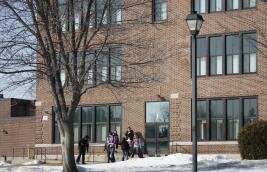 St. Cloud, Minn. — The St. Cloud Area School District says it’s working hard to address some students’ complaints of racial harassment.
St. Cloud, Minn. — The St. Cloud Area School District says it’s working hard to address some students’ complaints of racial harassment.
A Muslim civil rights group has asked the U.S. Department of Education to investigate racial and discriminatory incidents at high schools in both St. Cloud and Owatonna.
Some Somali students at St. Cloud’s two public high schools say administrators haven’t responded effectively to their complaints, a charge the district denies.
When MPR News interviewed a handful of Somali students at Apollo and Technical high schools in St. Cloud last month, they talked about hurtful comments they’ve received from white students.
Aziza Mohamed, a student at St. Cloud Technical High School, said classmates have told her, “You guys, Somalians, come here and expect everything to be paid by the government.”
One of her classmates, a freshman at Technical High, also said a classmate in science class asked her and Mohamed why they don’t go back to their country.
Others talked about hurtful comments they’ve received from white students about the way they smell.
The Minnesota chapter of the Council on American-Islamic Relations, or CAIR, filed a complaint with the U.S. Department of Education last month that lists more severe allegations of harassment by students, some teachers, and even a bus driver.
For nearly a year CAIR has been working closely with the school district to address racial, religious, and cultural tensions at the St. Cloud are high schools. CAIR’s Zahra Aljabri says she and her colleagues have reported these problems to principals, vice principals, and the superintendent, but the problems continue.
“This is larger than we can handle and we need someone who has more experience and more knowledge on these issues to deal with this,” Aljabri said. “None of the people on CAIR are educators or teachers or anything like that, so we don’t feel best equipped to give more than we already have.”
CAIR has documented a series of face-to-face meetings and email exchanges with several school administrators dating back to June of last year and the organization has conducted mediation sessions and diversity trainings for district staff.
Superintendent Steve Jordahl acknowledges that his district was aware of some student-to-student harassment and the incident involving a bus driver. Jordahl says the district took disciplinary action, although he wouldn’t share details. He said he doesn’t think the civil rights group alerted administrators to any harassment of students by teachers.
He says administrators always document and address harassment incidents.
“It’s never come to my attention that if they have shared that information with administrators … then our administration turning and saying, ‘We’re going to ignore this,’ that wouldn’t be true,” he said.
Jordahl acknowledges that his district still has a long road ahead to ease racial and cultural tensions, but he and other school administrators say the recent media spotlight of these challenges overshadow the district’s efforts to address them.
Luis Saenz, the district’s director for educational equity, said the district’s five-year strategic plan includes a focus on easing cultural tensions. He says the school district has hosted two cultural awareness panels and a respect retreat so far this school year.
“One of the other items that we were fortunate to work with is with our respect retreats and having students from different demographics come together and talk about — in structured learning circles — about what is it to respect self, what is it to respect others, how can we stand up for the value of respect and really having that be a core value in our district as we seek to continue to address some of these concerns,” he said.
Saenz said the schools also have several “cultural navigators,” who provide support to both students and teachers on campus.
One community member who hopes the school district succeeds in its efforts is Kevin LaNave, the director of a local nonprofit, the Center for Service Learning and Social Change, that works with youth, educators, and adults on social justice and peace issues.
LaNave says he believes the school district wants to solve these problems but, he said, “I don’t think it’s appropriate for anyone to suggest that because the district is doing those things, there isn’t also significant pain and problem that still needs to be addressed.”
LaNave says he and many other community members want to help the district resolve these racial, cultural, and religious tensions. The U.S. Department of Education will decide later this month whether it will investigate the recent complaint filed by CAIR.
According to a spokesperson, the department’s Office for Civil Rights has received 140 complaints involving race and/or national origin harassment since October 2006: 77 involved elementary/secondary education, 58 involved post secondary education, and five involved other types of institutions.
_____
MPR






